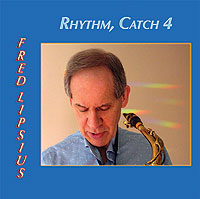Born in the Bronx, New York City on November 19, 1943, Fred began playing the clarinet at age 9, alto and tenor saxophones in Junior High School, and piano at Music and Art High School in Manhattan. He continued his studies at Berklee School of Music (1961-62), and then went on the road… Fred is currently an Associate Professor at Berklee College of Music, where he’s been teaching full-time since 1984.
Fred Lipsius played on the last cd release Global Vision of George Trantalidis http://www.jazzonline.gr/en/cd-releases/item/46-global-vision%E2%80%9D.html
About the CD and tunes (in order of tracks):
This is Fred’s first jazz sextet recording as a leader. In his liner notes he says: “I went through all my jazz compositions and chose these 12 for the CD. They were penned at different times in my life, but always carry the influences of my musical heroes”. Originally, Fred intended these tunes and arrangements for an educational book/CD, but after hearing the horns record some of the tunes, he quickly changed the project to a jazz CD, featuring all the band members. (1) “Rhythm, Catch 4” (the title tune of the CD) is an up-tempo melody based on the standard “I’ve Got Rhythm”, and has the whole band ‘catching’ (or punctuating) beat 4 at places in the melody. Fred’s tenor sax playing is spotlighted. (2) “Folk Song”, written by Fred around age 18, begins with a simple theme that repeats and varies throughout the tune with interesting chord harmonies. It’s similar to what Bartok did, taking simple European folk melodies and putting his own harmonies to them. (3) “Some Things You Ain’t”, based on the chords to “All the Things You Are”, begins with Fred playing solo alto sax - improvising ‘freely’ over the whole tune’s chord structure. The rhythm section enters with Fred playing the melody, and then improvising over 3 choruses of the tune (each chorus, modulating into a new key). Fred takes the tune out, playing the melody in the original starting key, and ends the tune. (4) “Where At?” was inspired by hearing Miles Davis with John Coltrane and Cannonball Adderley. The 1st, 3rd, and 5th eight-bar sections of the melody use only a D7 (altered) chord for the harmony. (5) “Nippon” (means Japan), a fusion tune, reflects impressions of Japan. (6) “Basie-like” begins with a bass solo followed by the 3 horns playing the tune with a sound reminiscent of the Count Basie Orchestra. (7) “One For Trane”, dedicated to John Coltrane, is a jazz waltz using similar chords as Coltrane’s chordal reharmonization of “But Not For Me”. (8) “The Clear Islands” is an up-tempo Latin melody featuring ‘hot’ solos by the trombone and trumpet players. (9) “Bluesy Hues” contains simple, ‘bluesy’ melodic phrases over a chord progression of all Dominant Seventh Chords. (10) “Before and After” has touches of music by Bird ‘n Diz, Horace Silver and Benny Golson. (11) “Balloon Ride”, the other jazz waltz on the CD, takes the listener on a trip in a hot air balloon. The melody is based on a 4-note pattern that Chick Corea showed Fred. Fred used unique chord progressions for the A and B sections of his tune. (12) “Shuffle Blues” was one of many tunes Fred composed for his small group ensemble students at Berklee College of Music. This track features Fred throughout and is the closer for the CD.
The Musicians:
- Fred (alto and tenor saxes)
- Jeff Galindo (trombone) was Esperanza Spaulding’s Musical Director.
-Greg Hopkins (trumpet/flugel horn) played and arranged for Buddy Rich.
- Les Harris, Jr. (drums) played with Diana Krall, Clark Terry, Phil Woods, Marian McPartland, Scott Hamilton, and The Artie Shaw Orchestra.
- Russ Hoffmann (piano and electric keyboard) played with James Moody, Rufus Reid, Joe Zawinul, Billy Hart, Bobbie McFerrin, and Paula Cole.
- Dave Clark (bass) played with Gary Burton, Danilo Perez, Dave Leibman, Terri Lynn Carrington, Lee Konitz, and John Abercrombie.
Buy the CD

